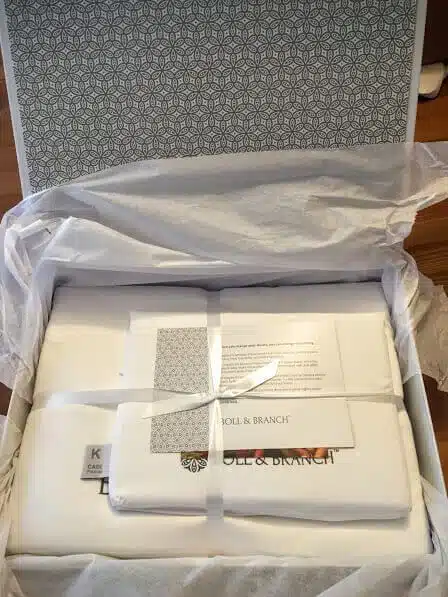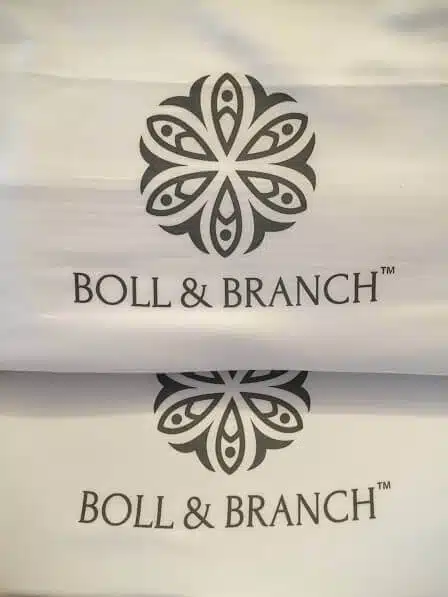Boll and Branch Signature Hemmed Sheets Review — A softer kind of luxury
Luxury can be loud — flashy packaging, inflated thread counts, endless claims. Then there’s Boll & Branch, quietly doing its thing: making sheets that feel like calm itself. This is the kind of comfort that doesn’t need a spotlight. It just meets you where you are, night after night.

The first impression
Unboxing these sheets feels different. No plastic wrap, no synthetic smell. Just fabric folded with care, tied neatly like a gift. There’s something refreshing about a brand that doesn’t need theatrics — it simply lets the product speak. The cotton feels substantial even before washing, soft but not limp, with that gentle resistance that promises a good drape once on the bed.
I slipped them on a hybrid mattress with deep corners and the fit was spot on. The elastic band held tight without strain. Lying down, the fabric felt grounded — cool at first, then warm enough to feel settled. It’s the kind of surface you can forget about, which is exactly what you want from a good sheet set.

Craft that holds up
After years of testing bedding, I’ve learned that softness alone isn’t enough — it’s about how that softness is built. Boll & Branch uses long-staple organic cotton spun into a sateen weave. That’s what gives these sheets their buttery texture without sliding into slick territory. The fibers are strong, so instead of thinning over time, they break in like denim — softer, smoother, more personal with age.
The hems are straight and clean. You won’t find stray threads or sloppy corners. It’s the kind of sewing that reminds you someone, somewhere, gave a damn. And yes, it’s Fair Trade Certified, which is rare in luxury bedding. You can feel good about what you’re sleeping on — literally and ethically.

The feel — and how it changes
The first few nights, the sheets felt smooth with a hint of crispness. After a couple of washes, they settled into something quieter — like the softness of a well-worn shirt. There’s a touch of weight that gives a sense of being covered, not smothered. It’s cozy without trapping heat, and breathable enough that I never woke up kicking the covers off.
This is where Boll & Branch stands apart from cheaper sateens. The finish doesn’t wear off. It matures. The texture goes from refined to intimate, and you start noticing how it responds to you — how it cools quickly when you shift, how it hangs naturally across the body instead of clinging. It’s tactile without ever demanding attention.
The long game
Good bedding doesn’t reveal itself overnight. A few months in, these sheets still feel rich. The weave hasn’t loosened, the color hasn’t dulled, and the edges haven’t curled. They’ve been through hot nights, lazy mornings, and plenty of washes — and they’ve come out better each time.
They’re not “perfect” in a showroom sense — they’re better. They have character. They wrinkle just enough to remind you this is real cotton, not a polyester blend pretending to be something else. And that’s exactly the charm.
Who they’re for
If you run hot, or if you can’t stand that clingy feeling most sateens have, these are your lane. They’re breathable, balanced, and forgiving. They suit anyone who wants quality that isn’t performative — just honest fabric, ethically made, built to last. Think of them as the linen equivalent of a well-cut white tee: classic, dependable, quietly premium.
Bottom line
Boll & Branch sheets aren’t cheap, but they’re not showy either. You pay for integrity, and it shows up every time you make the bed. They feel soft in a real way — not chemically treated, not exaggerated. Just deeply comfortable. They earn your trust slowly, the way the best things do.
If you’ve ever chased “hotel quality” and ended up with something lifeless, this is your reset button. These sheets don’t try to impress you; they simply deliver. And that’s worth every dollar.
Boll and Branch versus comparable sheet sets
Pricing reflects typical queen sizes before promos. Always confirm current discounts before checkout.
| Set | Fabric & Weave | Queen Price | Trial | Warranty | Highlights |
|---|---|---|---|---|---|
| Boll & Branch Signature Hemmed | Organic long-staple cotton sateen | ≈ $279 | 30 nights | Limited | Fair Trade, buttery soft, deep pockets, long lifespan |
| Brooklinen Luxe Sateen | Cotton sateen | ≈ $189 | 365 nights | 1 year | Silky, bright color options, great return policy |
| Parachute Sateen | Egyptian cotton sateen | ≈ $239 | 60 nights | Defects only | Matte finish, heavier drape, minimalist style |
| Cozy Earth Bamboo | Viscose from bamboo | ≈ $319 | 100 nights | 10 years | Ultra-cool feel, fluid drape, premium price |
| Saatva Organic Sateen | Organic cotton sateen | ≈ $245 | 45 nights | 1 year | Matte finish, heavier hand, eco-certified |
Yawnder scorecard
We may earn a commission when you click through and make a purchase.


